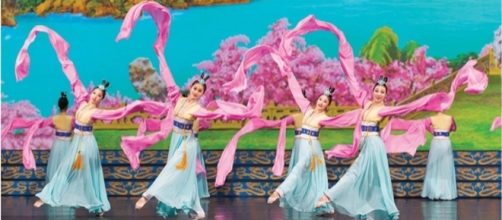On Wednesday, May 3, NJPAC’s Prudential Hall, in Newark, saw the opening of Shen Yun’s six-performance run, a Chinese cultural, historical spectacle. In a word: It’s thrilling. Maestro Yuan Gao leads the Shen Yun Orchestra, a 40-piece Western-style symphony that adds various traditional Chinese instruments. The dancers (six female and four male principals; 20 ensemble members) populate the stage, mostly in groups numbering 13-16, and portray China’s ethnicities and epochs ranging from time’s beginning to the 1990s, through the three modes of Chinese Classical dance: ballet, ethnic and folk dance.
Three solo numbers feature a tenor, a soprano and an erhu player accompanied by an onstage pianist in a widely diverse program.
Musical coherence
Junyi Tan and Jing Xian are the composers whose 17 orchestrated works richly vary the musical palette for sentimental stories, heroic tales, battle scenes, bucolic idylls and modern urban settings, even a riot or two in modern dress. For ears not accustomed to Eastern music, the peril of a certain sameness encroaches despite so much variety. But never fear, sameness of this sort is most welcome. The lush orchestration and melodious, rhythmic character remind one very much of Austro-Hungarian composer Franz Lehár (1870-1948), particularly his three-act romantic opera “Das Land des Lächelns” (The Land of Smiles; 1929), partly set in early-20th-century China.
Mr. Tan and Ms. Xian achieve interwoven coherence throughout the disparate episodes.
Helpful cues and clues
Nancy Zhang and Ben Freed, whose voice has that unique Broadway timbre, serve as masters of ceremonies. Their concise bilingual introductions set up each piece comprehensibly. Seemingly over-eager orchestra members demonstrate the various instruments—especially helpful in the case of the ancient instruments, less-known in the West.
The emcees’ impeccably polished banter is almost too perfect, as they turn on cue toward each other at least twice during each introduction and gesture predictably. But she comes across as charming and he, as an efficient showman.
Interactive artwork
Dancers appear before an endless array of designer Ken-Chieh-Hsu’s high-definition interactive backdrops, depicting Tibetan or Mongolian mountainous vistas, temple interiors, even a subaquatic palace.
Flying characters zoom toward the audience, vanishing at the edge of the screen precisely when those characters pop up in the flesh. A three-step riser along the screen is both landing strip and launch pad for airborne arrivals and departures. Special effects include deafening explosions, conflagrations, and Armageddon-type divine intervention, usually when the Communists are about to throttle to death the last persecuted member of society.
Costumes and choreography
Lithe dancers, seemingly of identical height, come clothed in intensely bright colors, sinuous fabrics that are sometimes diaphanous, always tasteful, and run the gamut from exquisite elegance to folk simplicity. Five choreographers create 17 unique dance scenes.
One of the several recurring how-do-they-do-that effects is the women’s quick gliding, with shoulders, arms, and head unmoving, totally swaggerless. Not their exclusive province, but the men dominate the flying leaps and aerial flips field. “Stunning” continually comes to mind in seeking to describe their prowess.
Spot-on timing
Better than any Western dance company, the dance troupe’s most outstanding achievement has to be their staggering synchronicity. Astounding two- and three-foot-high leaps launch at the same split second, rise to the exact same height, leg and arm extensions perfectly matched. Whether spinning or balancing, the ensemble shadows the principal dancers’ every move with utter precision.
Ironically, doing the same thing at the same time suffers no peril of stale, stultifying sameness.
Justifiable chip
Shen Yun is unwelcome in mainland China. And no wonder. The majority of its artists hail from there, yet among the glories of its history, they also include its sadder pages of modern repression and outright persecution of Falun Dafa (Falun Gong). Such oppressive acts are becoming all too common, seemingly everywhere. A source close to the company said Communism effectively ‘murdered the Chinese collective soul,’ formerly so rich in spiritual elements.
A story that needs to be told
Overheard in the audience: ‘My, so many spiritual elements!’ Indeed, Taoism, Buddhism and Falun Dafa all figure prominently in many segments.
Operatic soprano Min Jiang in “The Dream” powerfully urges: “Seek out the followers of Dafa to truly understand.” And tenor Guimin Guan eloquently sings that “Dafa, the Great Way,” is the path to heaven. If Shen Yun can be faulted with anything, it gives the impression that it’s trying too hard. And yet, who can blame them? They are pushing back against Big-Bully politics that has gutted their society. That story should not be squelched.
What we have in common
To its credit, Shen Yun emphasizes what humanity shares, the “sameness” in us all despite our cultural, ethnic, national or linguistic backgrounds. Xiaochun Qi plays a moving “Delicate Song” on erhu, a two-string instrument bowed (like a cello) in front, but small enough to rest on her lap.
It’s soulful tones imitate the flute’s lower-register richness, while the upper range emulates the human voice. Qin Yuan accompanies her—and the singers—at the piano. A moment of quiet reflection, it sets the audience to thinking: Why can’t we just get along and marvel together at the beauty in all of humanity?


